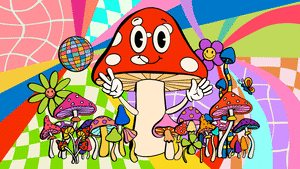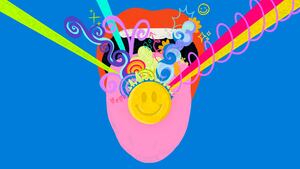Editor’s note: Rob Long is not a medical professional or licensed provider of psychedelics. He may, in fact, be high while writing this column. Nothing herein constitutes pharmaceutical advice or guidance, and should not be used to inform diagnoses or treatment.
Not too long ago, I watched a certifiable, internationally famous movie star record a public service announcement. He walked up to the microphone, adjusted the lectern, cleared his throat and then, without even looking back, extended his right arm behind him.
His fingers opened, and suddenly a bottle of cold water was right there. How? Because his assistant, in a constant state of anticipation, knew that his boss would reach out for the bottle—and had it prepared.
The movie star never bothered to check to see if it was coming. He didn’t need to. He took a long sip and, again, reached back without looking, this time dropping the bottle back in the assistant’s waiting hands. He looked up from his script and asked, quietly, “So, are we ready?”
Now that, I thought to myself, is what living in a bubble must be like.
It’s easy to forget, for most of us, how all-embracing such a cocoon can be for the lucky few. There’s always someone wondering what, exactly, you might need to make yourself happy. Or if not happy, at least content. The water you might want to drink; the shoes you might like to wear; the itch you might need to scratch—whatever occurs to you, whether by whim or necessity, is planned for and prepared and, in the case of my movie star friend, ready to be plucked out of the air, unseen. It must be nice.
But all of that cosseting comes with dark complications. As Matthew Perry, the late star of the long-running sitcom Friends discovered, when you’re rich and famous there is always a doctor willing to prescribe a powerful and potentially addictive drug. Always a dealer willing to sell to you when that prescription runs out. And always someone willing to inject you with as much as you like, as often as you like.
What appears to have happened to Perry was this: After years of mostly unsuccessful battles against addiction—to alcohol, opioids, Vicodin, amphetamines and I’m probably missing a few things, and which led to a ruptured colon, at least one total cardiac arrest and two weeks in a coma—someone in his orbit introduced him to the drug that eventually killed him. That drug was ketamine.
Ketamine is everywhere these days. It’s a legal, though controlled, substance, and approved by the US Food and Drug Administration for psychological use. That’s why psychiatrists can offer it to patients during sessions and why there are clinics that offer ketamine infusions to people with otherwise drug-resistant depression.
(Ketamine is known for rapidly taking effect and just as rapidly leaving a user’s system. That’s one of the reasons it’s popular with therapists—a patient can take a ketamine lozenge, have a deeply productive session and be back to normal within the 50-minute “professional hour.” That isn’t the case with, say, MDMA.)
This is also why it seems like everyone can get some without too much trouble. Depending on the crowd you run with, it’s easily available as a nasal spray or a powder for fun nights out. Ketamine, people say, has all the social benefits of cocaine without any of the drawbacks. It delivers good feelings without making you an asshole—although you can also get ketamine in a cutesy lollipop form, which is about as asshole as it gets. Where I live, in New York City, it’s easier to get than a pack of unfiltered Lucky Strikes.
It’s not exactly a psychedelic; the most accurate way to describe it is psychoactive. At lower doses, it makes a user feel good and less guarded. At higher doses, it can help adjust brain functions. At still higher doses, it can put you to sleep for surgery.
And if you’re not very careful with it, it can kill you.
But what, exactly, is ketamine? Originally developed as an anesthetic, ketamine was extensively used by medics in the early 1990s during the first Gulf War. Its ability to induce anesthesia quickly and effectively, without depressing respiratory functions, was particularly valuable in the improvised and resource-constrained battlefield environment.
There were other benefits too. During its use, some patients reported feelings of detachment from their bodies and hallucinations—this is a good thing when you’re talking about war trauma, or trauma more broadly. Researchers soon begun to study it as a potential treatment for depression. Unlike traditional antidepressants, which can take weeks to show effects, ketamine’s impact on the brain’s NMDA receptors—part of the glutamate system, which is involved in mood regulation—produced almost immediate relief from depressive symptoms. These benefits led to the off-label use of ketamine infusions and, eventually, the FDA approval of esketamine, a nasal spray derived from ketamine.
Ketamine is today classified as a Schedule III controlled substance—up there with steroids, Tylenol with codeine—and is legally available in all sorts of doses and forms. As long as you’ve got a prescription, you can get it at CVS.
Which is where Matthew Perry—and a lot of people—come into the picture. Perry was, presumably, prescribed ketamine for psychological reasons. Clearly, he was a man fighting a lot of demons, and it must have seemed like ketamine could help. But it’s also undeniable that it eventually replaced his addiction to opiates. For Perry, ketamine was not a “safe drug.” Are the people who offered him access to it culpable in some way? That, at least, is what the Los Angeles DA believes: Last week, five people were indicted in Perry’s death: two alleged drug dealers, two doctors and his personal assistant who allegedly injected him with his fatal dose.
According to reports, Perry was snorting, sucking and injecting ketamine. His use was full-spectrum and out of control. And (of course) no one in his immediate circle could stop him. Or maybe no one tried.
That’s how it is when you’re in that celebrity cocoon. You reach behind you without looking and a bottle of water appears—or something a lot more potent. There is always someone close-by ready to serve. Perry’s last words, according to court records, were to his assistant: “Shoot me up with a big one.”
And because he was rich and famous, that’s exactly what he got.
Rob Long is a television writer and producer and author of three books. His weekly podcast, Martini Shot, is available everywhere. Contact him at rob.long@thedailybeast.com.
Anyone seeking medical advice should contact their doctor or a health professional; anyone seeking support for depression or suicidal thoughts should reach out to the National Suicide Prevention Lifeline by dialing or texting 988.








